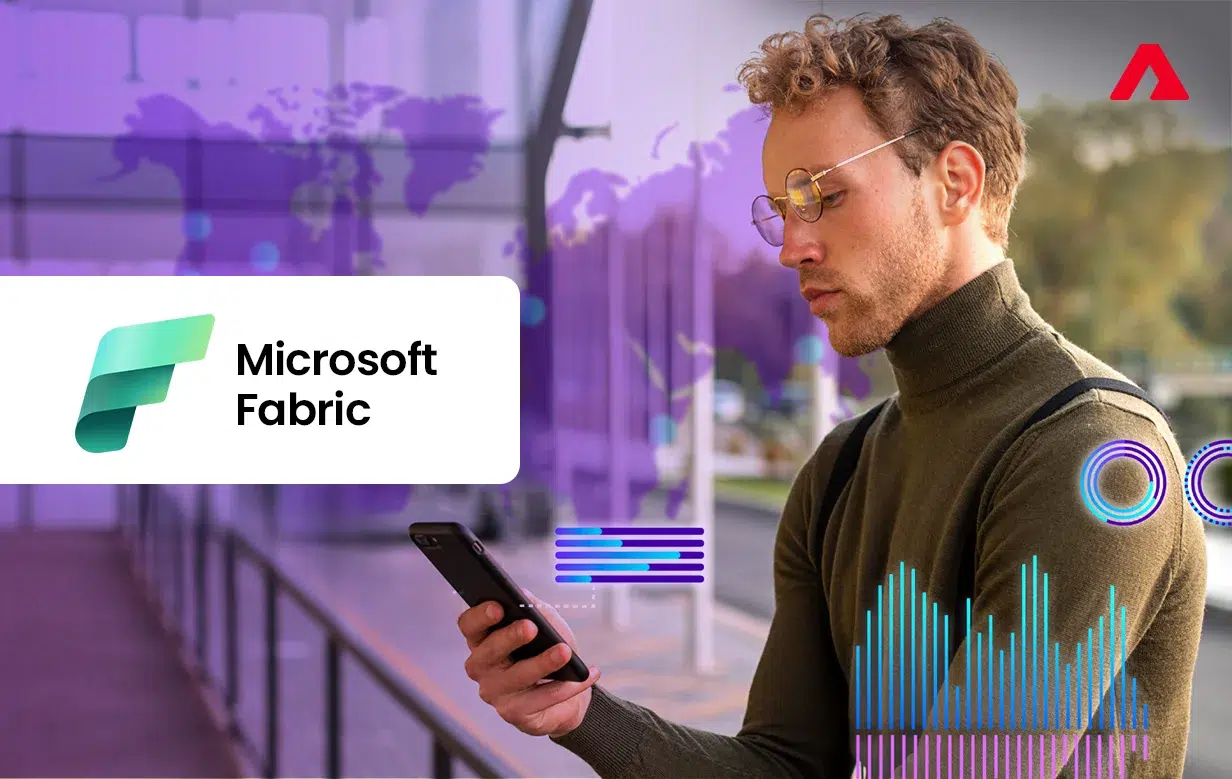Data has become the lifeblood of modern businesses. Every click, transaction, and interaction generates information that holds potential insights. But managing and extracting value from this constant flood of data is far from simple. Traditional systems often buckle under the pressure of handling massive volumes, fragmented sources, and real-time demands. This is where Microsoft Fabric steps in, offering a unified and future-ready approach to analytics that is designed for the realities of the AI-driven era.
In this blog, we’ll explore what Microsoft Fabric is, why it matters, and how it is reshaping the way organizations approach data analytics.
Understand more about Microsoft Fabric
Microsoft Fabric is a comprehensive analytics platform developed by Microsoft to bring all your data tools under one roof. It seamlessly combines capabilities like data engineering, data science, real-time analytics and business intelligence, removing the hassle of switching between different systems. With everything connected in one ecosystem, it helps businesses manage, analyze and act on their data more efficiently.
Unlike earlier systems where companies relied on separate services for warehousing, reporting, and machine learning, Fabric provides a one-stop solution. It integrates with Power BI, Azure Data Factory, Synapse Data Engineering, and other services under one umbrella. This consolidation ensures that organizations can move from raw data to actionable insights without friction.
For businesses navigating the complexity of hybrid data environments, Fabric provides the missing piece — a holistic platform that makes working with data more, less about managing tools and focused on delivering value.
Why Fabric Stands Out in the Analytics Landscape
The promise of Microsoft Fabric lies not just in its technical depth but in its ability to simplify the messy world of data management. Historically, companies faced a choice: either stitch together several specialized products or accept the limitations of one-size-fits-all tools. Both options came with trade-offs in cost, scalability, and usability.
Fabric reimagines this by offering:
- A single data lake architecture, called OneLake, which acts as the foundation for all data storage and access.
- Tight integration with AI models and machine learning pipelines, which are essential for businesses preparing to compete in the AI economy.
- Seamless governance and security, so companies can scale without worrying about compliance or fragmented oversight.
More importantly, Microsoft Fabric is not just for data engineers or IT teams. Its design makes advanced analytics accessible to business users and decision-makers as well. That accessibility is key in an age where insights need to be democratized across organizations.
OneLake is the main Highlight of Fabric
At the center of Microsoft Fabric lies OneLake, a unified data lake designed to eliminate silos. Traditionally, data lakes and warehouses existed separately, requiring teams to move data between them for different purposes — often a time-consuming and error-prone task.
OneLake addresses this by creating a single repository where all data, regardless of type, can reside. Whether it’s structured financial transactions, unstructured customer feedback, or semi-structured IoT sensor readings, everything lives in the same environment. This ensures consistency, reduces duplication, and streamlines collaboration.
For businesses, this means analysts, engineers, and developers can all work from the same source of truth. No more version mismatches, no more reconciling multiple databases, just a unified foundation that allows for faster, more accurate insights.
AI in Analytics
We’re living in the time where AI is transforming industries like never before. From personalized healthcare to fraud detection in banking, machine learning is redefining how data is used. Microsoft Fabric is purpose-built for this environment, enabling AI-driven workflows directly within its platform.
With built-in tools for model training, deployment, and monitoring, Fabric makes it possible to integrate predictive analytics into day-to-day business processes. Imagine a retailer using Fabric to predict customer churn based on transaction data, or a logistics company forecasting delivery delays by combining weather data with real-time traffic updates.
The synergy between Fabric’s unified data ecosystem and AI capabilities helps organizations not only understand what has happened but also anticipate what will happen next. That predictive power is increasingly the difference between leaders and laggards in today’s data-first economy.
Real-Time Analytics with Fabric
In many industries, the value of data diminishes quickly if not acted on in real time. Think about fraud detection in financial services, monitoring patient vitals in healthcare, or optimizing ad campaigns on digital platforms. A delay of even a few minutes can mean lost opportunities or greater risks.
Microsoft Fabric addresses this with real-time analytics features that allow organizations to process streaming data alongside historical records. Instead of waiting hours or days for batch processing, businesses can respond instantly to emerging patterns.
This ability to combine real-time data with long-term history is particularly powerful. For instance, a manufacturing company could detect anomalies on the production line in real time, while also referencing historical maintenance logs to determine whether an issue signals a recurring problem.
Empowering Decision-Makers
One of the common criticisms of analytics tools has been their steep learning curve. Often, valuable insights remained locked away in the hands of specialized analysts, leaving decision-makers reliant on filtered reports.
Microsoft Fabric seeks to change that. By embedding advanced capabilities into familiar interfaces like Power BI, it makes insights more accessible to non-technical users. A sales manager can explore data dashboards without needing to know SQL, and a marketing executive can visualize campaign performance without depending on IT teams for every query.
This democratization of analytics ensures that knowledge flows freely across organizations. In a world where agility matters, empowering more people to access and interpret data can be a game-changer.
Some Considerations with Fabric
Of course, no platform is perfect, so is the Microsoft Fabric. It offers immense potential, businesses need to approach it strategically. Migrating to Fabric requires planning, especially for organizations with legacy systems and complex workflows. Costs can vary depending on scale, and like any powerful tool, it demands proper governance to prevent misuse or redundancy.
Another key consideration is training. For all its accessibility, teams will still need to adapt to new processes and workflows. Companies that invest in change management and skill-building will get the most out of Fabric, while those who treat it as a plug-and-play solution may find themselves underwhelmed.
As AI transforms with the speed of light, tools like Microsoft Fabric are likely to become indispensable. The sheer scale of data being generated today means businesses can no longer rely on fragmented or outdated systems. Unified platforms that combine storage, governance, analytics, and AI are not just nice to have, they’re essential.
Microsoft’s long-term investment in Fabric signals its recognition of this trend. For enterprises, the challenge is not whether to embrace such platforms but how quickly they can adapt to stay ahead.
Conclusion
Microsoft Fabric is more than just another analytics tool. It represents a shift toward unified, intelligent platforms that are tailored for the AI-driven economy. By simplifying data management, enabling real-time insights, and embedding AI into everyday workflows, Fabric is helping organizations reimagine what’s possible with data.
But technology alone is never enough. To fully leverage tools like Fabric, businesses need the right strategy, expertise, and execution. This is where trusted partners can make a difference.
At Atharva, we’ve worked with companies across industries to build scalable, future-ready data solutions. From setting up robust architectures to guiding organizations on their analytics journey, we help businesses turn platforms like Microsoft Fabric into real competitive advantages. If you’re ready to transform the way your organization works with data, our team is here to help you navigate the process with confidence.
Contact us at contact@atharvasystem.com
Visit us at https://www.atharvasystem.com to learn more.
FAQs
1. What exactly is Microsoft Fabric?
Microsoft Fabric is an all-in-one analytics platform designed to bring every aspect of data management together. It seamlessly unifies data engineering, data science, real-time analytics and business intelligence within a single, integrated environment.
2. How is Microsoft Fabric different from Azure Synapse?
While Azure Synapse focuses primarily on data warehousing, Microsoft Fabric goes further by integrating data lakes, real-time analytics, AI workflows, and Power BI under one umbrella.
3. Can small businesses benefit from Microsoft Fabric?
Yes. Fabric is designed to be scalable, meaning smaller businesses can start with what they need and expand as their data and analytics requirements grow.
4. Does Microsoft Fabric support real-time data?
Absolutely. Fabric includes features for processing streaming data, making it ideal for industries where immediate insights are critical.
5. How secure is Microsoft Fabric?
Security is built into Fabric with governance tools, compliance frameworks, and integration with Microsoft’s enterprise-grade identity and access management systems.
6. What industries can benefit most from Fabric?
Any industry dealing with large or complex datasets can benefit. Common examples include finance, healthcare, retail, logistics, and manufacturing.
7. How can Atharva help with Microsoft Fabric adoption?
Atharva provides expertise in implementing and customizing data platforms like Microsoft Fabric. We help organizations plan migrations, optimize workflows, and ensure they get the most value from their investment.




 Insurance
Insurance


























